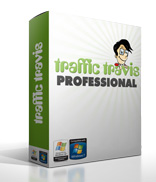Traffic and SEO

Let’s be clear about the difference between SEO efforts and driving traffic.
- SEO (both on-page AND off-page) aims at improving Search Engine Ranking Positions (SERPs).
- With an increase in SERPs comes an improvement in traffic… generally.
- Other methods are more directly aimed at specifically driving traffic.
- They may also indirectly contribute to SERP improvement.
SEO traffic, especially Google SEO traffic, is like chasing a wild goose, very nice if you can catch it, BUT…
- You don’t want to focus all your efforts on the pursuit.
- It’s more important to actually get the traffic.
- SEO is only one of many available options.
- The actual source of traffic is less important as long as it is targeted.
It took me forever to separate in my own mind the concepts of SEO and SERPs from the idea of generating traffic directly. SEO and SERPs are important for getting organic search engine traffic, but search engines are only ONE source of traffic.
The main goal should be to drive traffic. All kinds of targeted traffic, not just search engine traffic. Many of the things you can do to drive traffic directly to your site will also help improve SERPs but that is (and should be, I think) a secondary effect.
The five main sources of traffic are:
- Paid Traffic – Instant response but lasts only as long as the money holds out
- Backlinks – There are 10’s if not 100’s of ways to create them, some take longer to work than others, but all generally last quite awhile. Private Blog Networks are all the rage recently, but these can be rather expensive to setup not to mention time consuming.
- Email Marketing – Rather instant results but requires a list unless you pay for a ‘Solo Ad’.
- SEO Organic Search Engine – Massive traffic if you can get it, but it tends to take lots of time and effort, and it is VERY fickle. Here today, GONE tomorrow!
- Social-Viral – Can be very rapid response and massive traffic but it tends to be the least productive for conversions.
 Recently there has been a new development called ‘Re-targeting’. Re-targeting uses a tiny pixel or a JavaScript tag in the footer of your website to place an anonymous re-targeting “cookie” on a visitor’s machine. This code creates a list of people that visit your site. This list allows re-targeting vendors to display re-targeting ads to your potential customers as they visit other sites.
Recently there has been a new development called ‘Re-targeting’. Re-targeting uses a tiny pixel or a JavaScript tag in the footer of your website to place an anonymous re-targeting “cookie” on a visitor’s machine. This code creates a list of people that visit your site. This list allows re-targeting vendors to display re-targeting ads to your potential customers as they visit other sites.
So, when a browser visits your site, a cookie is dropped and the visitor then gets repeated offers for the same or similar products as the one initially viewed. This can be a powerful way to increase conversions, but the original visit must come from some other lead or traffic source.
If you have created and will be marketing your own product, there is a sure-fire source of free traffic available only to you. It is known as ‘affiliate traffic’. You let your affiliates or Joint Venture (JV) partners worry about driving the traffic. You off-load the hassles of keeping up with the latest SEO trends on them. They send traffic to your sales site and you pay them a commission on each sale.
It might be smart to use that traffic to help build your email list. People who showed up to your site had an obvious interest in your product. If they weren’t ready to buy during that first visit, they may simply need a little gentle persuasion. Studies have shown that people need to see your offer 7 to 12 time before they pull the trigger. Email lists and re-targeting are just what the doctor ordered.
Of all the methods out there, the ONLY one you truly have complete control over is the Email marketing method.
Let’s explore these traffic methods starting with Paid Traffic.






